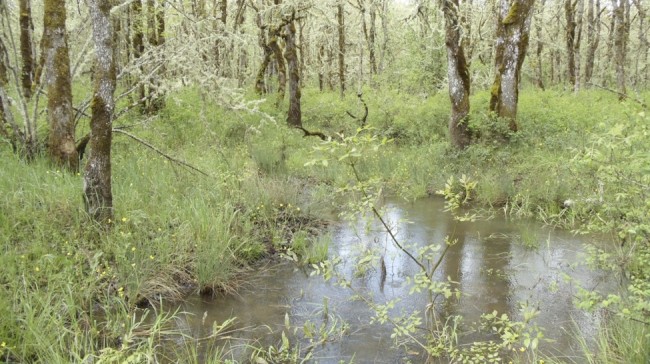Rivers to Ridges partners manage more than 1,600 acres of emergent marsh, and forested and riverine wetlands, along with associated upland habitats along Coyote and Spencer creeks upstream of Fern Ridge Reservoir west and southwest of Eugene. Numerous partners and private landowners are working together to connect and enhance these truly unique habitats, help maintain the special rural character of the area, and provide important wetland functions such as flood storage, water filtration and sediment capture – all within a productive agricultural landscape that is a favorite destination for cyclists and wine enthusiasts.
A history of partnership and vision
Rivers to Ridges partners, along with Ducks Unlimited and the Institute for Applied Ecology, work together with farm, ranch and timberland owners upstream of Fern Ridge Reservoir to creatively address fish and wildlife habitat, recreation and water quality opportunities alongside productive lands that raise food and fiber products for the people of the region, for Oregon and beyond.
Conservation in the Coyote Creek basin began with a partnership between the U.S. Army Corps of Engineers and Oregon Department of Fish and Wildlife to manage the Fern Ridge Wildlife Unit in the wake of the construction of Fern Ridge Dam in 1941. The 2001 purchase of the Coyote Prairie property by The Nature Conservancy (who later transferred it to the city of Eugene in 2006), ushered in a new era of conservation investment around Coyote Creek by other Rivers to Ridges partners such as the McKenzie River Trust and the Long Tom Watershed Council.
Since the early 2000s, the Partnership’s focus has been on developing multipartner projects on high quality oak, prairie and wetland properties where farming, ranching and forestry are less financially viable and where conservation opportunities are highest. Rivers to Ridges partners continue to identify new opportunities for collaborative work on both conservation and private working lands, engaging with the farm, ranch and forestry producers in the local community, and finding new ways to connect scenic and wildlife habitat lands for the benefit of the public.
Increasingly, this area will be looked at as a recreational amenity for the region’s citizens, as Rivers to Ridges partners continue to explore how to make public access possible on more of these lands.
Special places, special creatures
Rivers to Ridges partners are not only protecting this important natural area for the community benefits it offers, but also for the truly unique assemblage of creatures that call Coyote Creek and the surrounding landscape home. Numerous wildlife species that are considered rare or sensitive by local, regional and national experts are found in the area.
In fact, several species that are either new to science or are found nowhere else in Oregon are found in the Coyote Creek area. The presence of so many special habitats and the species they support has helped leverage new projects, and the Rivers to Ridges partners have had tremendous success in garnering support for our continued efforts in the area.
Get out there
Fern Ridge Reservoir has been designated an “Important Bird Area” (IBA) by the Portland Audubon Society and is known to host more than 250 bird species over the course of the year. Fern Ridge is a vital stopover along the western flyway, and species such as black tern are known to occur nowhere else in the Willamette Valley.
A lazy, sinuous float along Coyote Creek’s oak-lined channel is a favorite destination of paddlers who want to get off the beaten track. In late spring, bring your binoculars and see lazuli buntings, slender-billed nuthatches and black-headed grosbeaks as you listen to Swainson’s thrushes call to each other from deep in the forest.
There are many ways to enjoy the greater Coyote Creek area. See the McKenzie River Trust website for a schedule of upcoming public tours on their properties as well Oregon Department of Fish and Wildlife’s website for recommendations for birdwatching, boat access and waterfowl hunting (in season).
